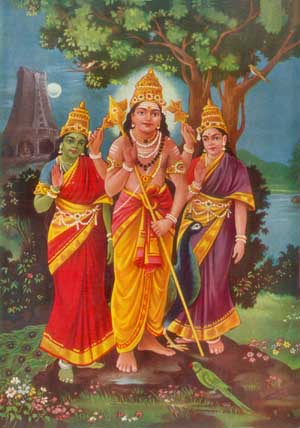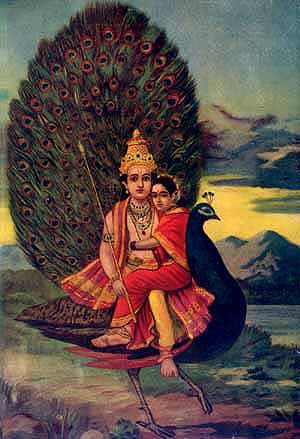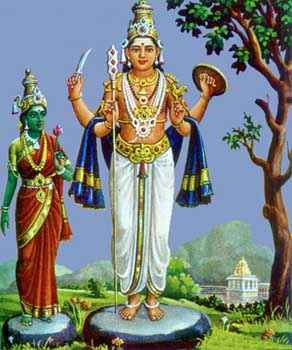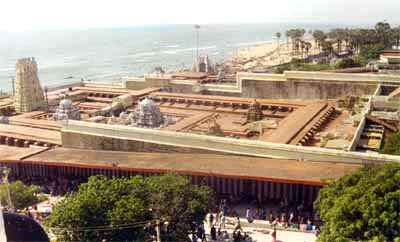
|
||||||||||||||
|
| ||||||||||||||
Tirumurugarrupadai—A Studyby Ratna Navaratnamfrom Karttikeya the Divine Child pp. 6-21
|
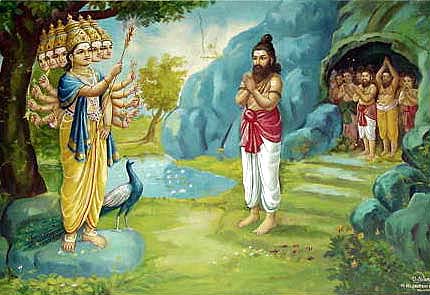 |
| Nakkirar saved his own life and that of 999 innocent people from the clutches of Karkimukhi, a demon, by singing Tirumurukatrupadai in praise of Muruka who came to his rescue at Tirupparankundram. |
Panoramic view of Tiruchendur temple and seashore |
It was on his way to Kailasa that he encountered the demon Ayakrivan and was captured by him and put in a cave along with 999 men of piety who had been made captives by this bhuta who wanted to perform a unique sacrifice of one thousand men in order to fulfill his penance. When Nakkirar arrived in the cave, his fellow captives were seized with grief as his capture spelt doom for all of them. Tradition declared that Nakkirar composed this illustrious poem on Muruga during this crisis, and invoked the Lord to guide him and also save his fellow captives from the impending danger. The place of captivity was a mountainous cave on the top of Tirupparankunram, and Nakkirar in the opening lines of the poem Tirumurugārrupadai extols its praise, as the holy abode of Muruga. When the poet finished his poem of praise, Lord Muruga appeared and killed the demon with his powerful Lance and rescued the thousand men:
“Kunram erinthāy!
Kuraikadalit Sūrthadinthāy!
Pūnthalaya
Pūthap Porupadaiyāy! Enrum
Elayāy-
Alagiāy! Erūrnthān Erēy!
Uiaiyāy en
ullathu uray.
Kunram Erinthathuvum
Kunrapōr Seythathuvum
Antrangu Amararidar
Thīrthathuvum—Intrenaik
Kaividā
nintrathuvum Katpothumpit Kāthathuvum
Meyvidā Vīrankai Vel.
T.M.G. Venba 1-2
He was also the author of Tiruvingoimālai Elupathu, Tiruvālanjuli Mummanikovai, Peruntēvap Parani, Tiruvelu-Kūtirukkai, Pōtri Kalivenba, Tirukannappatēvar Tirumaram and Nāladi Nāropatu. His poems are included in the earliest anthologies of Tamil poetry known as Narrinai, Kurruntokai, Ahanānūru and Puranānūru. His son Kiravi Korranār composed the famous poem on nature called Nedunalvādai, which is also included in the above anthology of the Third Academy of letters, which marked the glorious epoch of Tamil civilisation.
The Tradition:
Tirumurugārrupadai is the masterpiece of Nakkirar. It is the first idyll in the Pattuppāttu consisting of ten idylls which enjoyed popular esteem as marking the high watermark of Tamil poetry in the Third Academy of letters. Besides this, Tirumurugārrupadai is unique in that it is also included in the collection of the sacred Saiva religious poetry known as the eleventh Tirumurai. In this text, the author is exalted as Nakkira Deva Nayanar, Saint Nakkirar. The purport of the author is brought out in one of the closing stanzas of the poem itself:
‘In the face of fear, His
face of comfort shows!
In the fierce battlefield, ‘fear not', His Lance shows!
Think of Him once, twice He shows!
To those who chant His Name Muruga!'
(T.M.G. Venba 6)
This poem enjoys great popularity as a timeless work of art, and essentially it is the work of a religious mind, who drew his inspiration from the distinct religious tradition of his land and age. It is believed to be efficacious in that it acts as a healing balm on those who recite it, and even today, we find this poem sung with piety by many a devotee of Muruga.
What is the religious tradition, the peculiar religious import of this great masterpiece on Muruga? Its religious background has to be understood fully before we can enjoy its perennial beauty as a world's great poem. A study of the cultural, historical and literary background of the ancient Tamils will throw light on its exquisite poetic workmanship and the excellence of thought and content. It will also unfold in stages, the inherent religious faith and tradition of the people, who look upon Muruga as their favorite deity; their covenant with Muruga, through one of their illustrious poets Nakkirar in the Golden Age of Tamil poetry, has been enshrined in this immortal poem known as Tirumurugarrupadai.
The Academy of Letters (Sangam epoch) indicates the existence of a highly cultured community and it is on record that the body of Tamil scholars known as the First Sangam, Second Sangam and Third Sangam epochs extended their influence over a period of centuries before the dawn of thee Christian era—periods of great output alternating with comparative barrenness. This Academy of Letters was composed of scholars, poets, critics cited writers of great renown, whose imprimatur was necessary for the publication of any work of encyclopedic range in Tamil. A standard of excellence was set up, which had the insignia, the hall-mark of approval of the Sangam Laureate poets and authors. The later commentators and critics of these works, which were classified as the Sangam Works, have conformed to the critical standards established in the code of poesy and grammar embodied in Tolkappiyam, an extant work in Tamil attributed to the Second Academy of Letters, and dated prior to the fifth century B.C.
Ārruppadai:
In this background of Tamil Culture, a study of Tirumurugārrupadai offers great challenges. The poem has a peculiar technique that is unique to Tamil poesy. A bard or a seer, a poet of exceptional merit, who has enjoyed the benefaction of a king, a warrior hero, or a poet, and in rare instances the grace of a deity, in short one who has enjoyed the boon of an exalted One, meets another companion who is seeking out for similar favours. Out of the abundance of his munificence, the favoured bard recounts his experiences and extols the praise of his master and delineates his attributes and deeds with such delicate subtleties and poetic appeal; he thus points to a novice, the Way that shall ensure success in the attainment of winning the award. Herein is brought out a fundamental concept of the guru, the guide and master in Tamil tradition, who is ever prepared to show the Way he has trod, experienced and found beneficial, to other seekers who stumble in dubious highways and byways of life.
The illumined poet called as the Seer in the East, Nakkirar in this instance, beckons to one and all who waver on the crossroads of life, burdened with the penury of the mind, heart and body, the sick and the ailing, the aged and the feeble, the weak and the lost to follow the path, that shall take away from them their burdens of suffering and lead them to the goal of Muruga, the great benefactor, who shall reward them for their steadfast devotion and sacrifice. “The Way shall not be long and arduous, if ye but sing His praise and extol Him in the most sublime poesy." Such is the exhortation of Nakkirar, the master guide, and this kind of poetry came to be known as ārruppadai from the age of the Tamil Academy of Letters. In Tolkappiyam, we get the definition of ārruppadai poetry in the thirty-sixth sūtra of Purathinaiyal. Further Tolkappiyar elucidates the meaning of the nature of the award that the suppliant makes at the direction of the mature guide. It is kantazhi, which forms one of the three fruitful gains to be attained by worshipful devotion (sūtra 33). In other words, the goal is to attain the transcendent One, who is beyond all ties and forms:
“Sarpināt
tōnrāthu tālaruvai eporurku
Mēyanint
trenjnānrum inpam tagaitōr
Vāymozhyal
vākāl manattāl arivilanta
Tūiymaiya
tāna maitīr sudar."
Nakkirar's ārruppadai exhorts the struggling mortals to strive for the wealth of immortal bliss. This reward can be attained only through inward pilgrimage that takes one away from the path of the senses:
“Pulam Pirintu urayum
Selavu
Nēe Nayantanai Yāyin"
T.M.G. 64.
Nakkirar in Tirumurugārrupadai builds up a new tradition of ārruppadai by which he enunciates, that in the process of salvation of mortals, God's initiative is as intense as that of the devotee. Nakkirar invokes the grace of God Muruga to take the initiative and crown the devout seeker. In this poem, the guidance is given to Muruga by the kūliyar or the matured enlightened seers, who are already in possession of the grace of Muruga. That was the reason why Nakkirar's ārruppadai is named after Muruga as he is the One who is guided to come to his devotees true, in response to their supplication—
“Murugu ārrupadutha
Urugelu Viannagar." (T.M.G. 244)
According to Tolkāppiyar, ārruppadais are named after the persons who are given guidance, and not named after the patrons who are the objects of the guidance (Tol: puram: 30). Nakkirar's ārruppadai seems apparently to be named after the patron who is the ultimate goal of the guidance. However in lines 284-285 of Tirumurugārruppadai, the kūliyar or the attendants of Muruga appear on the festival grounds and draw the attention of Muruga to the earnest piety and spiritual fervour of the devotee, who has made this pilgrimage to Him, and who stands in need of His succor, moved as they are by his tuneful worship and praises of the Lord.
Thus it is evident that Nakkirar has not deviated from the traditional approach in his ārruppadai. Muruga is depicted as searching for the true devotee in order to shower his grace. The victorious leader of the devas, the spiritual Guru of the righteous seers, the great lover of the young, God Muruga is given guidance and His attention is draw to the ripe maturity of a devotee who also with high yearning has worked his way up to obtain His grace. It is both an outer pilgrimage to the hallowed abodes of Muruga, as well as an inward odyssey of the spirit. This aspect of Muruga worship is worked out more fully by M.A. Dorairangaswamy in his work on “Anbu Neriye Tamilar Neri" (p. 72).
All spiritual sojourns must be crowned by God's grace. A fervent devotee of Muruga — in this instance, poet Nakkirar—mediates with Muruga in the true role of a spiritual preceptor, to grant His benediction on the younger devotee who has been guided to come unto Him, with the ardent faith to receive His behest — that the Lord should turn His Eye of Grace on him, even as He has showered His Grace on the poet, and thus fulfill his supplication! This is Tamil culture at its pinnacle! It is lokasamgraha, the sovereign sway of Universal Love for all living beings! In the stinking culture of modernism with its tentacles of aggressive ego and pride and perversion of eternal values, it is salutary to recite Nakkirar's poem on Muruga and quench the thirst that doth rise from the soul for a drink divine. Such is the full import of Tirumurugārrupadai that is named after Muruga.
In this idyll, the favorite abodes of Muruga are described by the pathfinder, whose main aim is to turn the doubters arid wavering seekers to follow the right track, the royal way that shall lead each one of them to Lord Muruga. He dwells in special sanctuaries which are dedicated to His worship and termed centres of encampment (padaivīdu), reminding the followers that it was He who warred against the hordes of asuras, forces intent on destroying the good and the righteous order of this world. This humble sojourner, this votary of Muruga, is bidden to arise and go, and go at once to the temples at Tirupparankunram, Tiruciceeralavai, Kunruthoradal, Tiruvavinangudi, Tiruveragam and Pazhamuthircolai, and worship Him tunefully and receive His Grace.
Muruga is all-pervading in every particle of the universe, and while He is immanent in everything, everywhere and at all times, it is also true that man can experience an intimate nearness and presence in the temples especially dedicated to His worship. He cannot be seen nor heard, as He is beyond sight and sound; but the true seer can see Him in every phase of Nature's beauty and ugliness, in the calm serene beauty of the pastures green and mountain peaks, as well as in the horrors and weird scenes of the grim battlefield and in the terrors of brute force. This alternating phase of light and darkness is brought out majestically by Nakkirar in this poem of poems.
The Poetic Crescendo:
In this idyll, it is not a King or a chieftain who is extolled by the bard Nakkirar. He points the Way that shall lead a seeker to Muruga; it is the path of light, love and loveliness. The goal is Lord Muruga, the exalted Son of Siva, the victorious Lord whose abodes are endowed with such power and charm that the guide extols His glory in the most fascinating yet baffling melodious poesy, where nature, man and celestial devas enact a moving pageantry, and realise the award of the boon of grace from the living presence of Muruga. Unlike Dante who beholds at a distance the beatific vision with the sweet, river of Light dividing him poet Nakkirar transmutes that dross, of the earth into the molten gold of divine wisdom, and sees Muruga, Lord of heroic feats and wisdom, hears his word of Truth and experiences his Love -- the summum bonum of life, in blissful communion.
Let us examine Nakkirar's approach to Muruga, which is unique in its appeal. He is a peerless devotee of Muruga, steadfast in the pursuit of the Way that leads to Muruga; he exhorts the people to strive to acquire the spiritual wealth from this treasure cave. The reward is for those who make the inward odyssey to His abodes of wisdom found within each man:
“With a heart imbued with
love and purity,
And a will tuned to do His
bidding in virtuous acts,
If you seek His abodes,
then shall be fulfilled
All your cherished desires
and objects."
- .T.M.G. 62-66)
In this ārruppadai of Nakkirar, we get some poetic gems of purest ray serene, and soul-stirring descriptions of God Muruga and Mm abodes. We find exhilarating pen pictures of nature as the seat of His glory, of the sea and sky, hills and forests, fields and pastures, (Neytal, Kurinci, Mullai and Marutam regions classified by Tolkappiyar), of the sun and moon, of trees and flowers and the song of birds and prowess of animals. We cannot see God, neither can we hear Him; we can neither sense Him nor know Him. But the true seer sees Him in every phase of Nature's beauty and hears Him in every rustle of the wind and senses His joy in every note of the kuyil bird.
Like Dante's Divine Comedy, Nakkirar's poetic theme is pitched to the highest chord of praise unto the divine Jyoti. Muruga is depicted as the luminous Child, the refreshing youth radiating love and vitality, the young warrior who commands the immense array of heavenly hosts and earthly forces, the power of the bhutaganas and the milieu of the nether worlds; He is the enlightened embodiment of Siva, the sun of wisdom. Thus we see that Nakkirar conjures in all his poetic imagery, the concept of Muruga as testified in the local religious tradition, and in the legends.
Nakkirar delineates the types and modes of worship of this peerless God in his grand idyll. The lovers worship him with music and dance, and congregate in the open fields, or near the waterfalls; the priestly class worship Him with elaborate rites and ceremonies; the warriors celebrate his banner and lance; the rustic with food grains and sacrificial offerings; the aboriginal Veddas invoke Him with intoxicating drink and dance veriyādal. The devout aspirant meditates on him in silence, adoring Him as the Supreme God, the giver of all that is beneficial -- Subrahmanya.
Muruga is the all-pervading Spirit of the Universe, the Essence from which all things are evolved, by which they are sustained, and into which they are involved. Out of gracious compassion for suffering humanity, He takes forms sometimes as the youthful God of love, the mystic Child of Wisdom or the God of War in order to crush the forces of evil. He also appeals to the true seekers after the riches of the Kingdom of God, as the Divine Child Muttukumaran, a type of perennial tender beauty, always and everywhere wafting fragrance to rescue his devotees, with his consorts—Valli and Devayānai, who are the instruments of His Grace unto humanity and celestial beings.
As a literary poem, Tirumurugārrupadai is of great interest to all lovers of art and poesy. When we unravel its scintillating beauty, we also comprehend its profound religious meaning. It unfolds elements of poetry and drama combined with music—the three major aspects of Tamil literary tradition. The poem is made up of six scenes. God Muruga is represented as having taken His abode in six sacrosanct shrines, five of which are specific locations and Kunrutōrādal which has no particular shrine. Symbolically His six faces find their resting place in each of the six abodes. The seeker is bidden to undertake a pilgrimage and worship Him in Tirupparankundram, Tirucheeralavai, Tiruvāvinankudi, Tiruvērakam, Kunrutōrādal and Pazhamuthircolai,
Within this general framework, we discover the literary technique of ārruppadai, the way to Muruga depicted in six different forms and patterns of worship by six different types of adherents or worshippers. Each one of the six scenes is composed of a single unit of long-winding sentences, consisting of diction so profound, condensed in meaning, so that within the general ambit, each of the sentence structures is so broken up as to release a few clearly defined pictures arranged systematically, centering round Muruga, the object of worship; the devotees swing round his orbit as subjects with Nature around as the stage, on which the drama of man in his relationship to Muruga is enacted; Nature is the witness.
In this triangular panorama, the stage by which we mean the world of nature, the abode (padaivīdu) becomes at some point or other, the focal centre, where the poet has worked out his exquisite artistry. At another time, it is the object, the adorable Muruga who steals full attention and delicate details of His form, adornments, smiles, and actions add lustre to the poem. Lastly, we get scintillating pictures of the worshippers, the procession of devas, mortals, and the gamut of the celestial and human pageantry seeking Him, praising Him and supplicating unto Him in diverse ways and modes. Thus Muruga, His abodes and His gravitational pull on the fervent devotees who revolve round His axis—these three centrifugal pivots grip our hearts and minds and hold us spellbound. The one in three and three in six and six by six reveal to us the pinnacle of the sublime truth of religion. This indeed is great poetry and even if the peculiar halo of religion embodied in this poem were to wane at some unknown future in the history of mankind, this poem of poems will live on in eternity, as a peerless work of art.
Thus we trace the continuity of the cult of Muruga worship in Tamil Nadu from ancient times to the modern period, and find that Muruga is a living force today and rests upon an old tradition. Tamil literature, archaeology, epigraphy and iconography supply several kinds of data in this interesting study of Muruga cult, and this continuity is one of the main features of our study. Purānas record the legends -- legends praising holy places, temples and tirthams and explain the images; whereas technical treatises like the silpa sāstras, Kriyapāda of the Agamas and tantras like Kumara Tantra give the rules to build temples and to make the images and conduct pujas. The Tamil literature, like Paripadal, Tirumurugātrrupadai, Kanda Purānam and Tiruppugazh, reveal the intense piety of the devotees who built and worshipped in the temples of Muruga, and illustrate their emotional feelings and thoughts. An attempt has been made to utilize Tamil literary sources for the correct appreciation of the indissoluble links between the monuments and the religious thought and practice of the Tamils in regard to the worship of Muruga in Tamil Nād.
Layne Little's English translation of Tirumurugarrupadai
"Muruga Sadhana in Tirumurugarrupadai" by Ratna Navaratnam
Research articles on Skanda-Murukan
|
|
